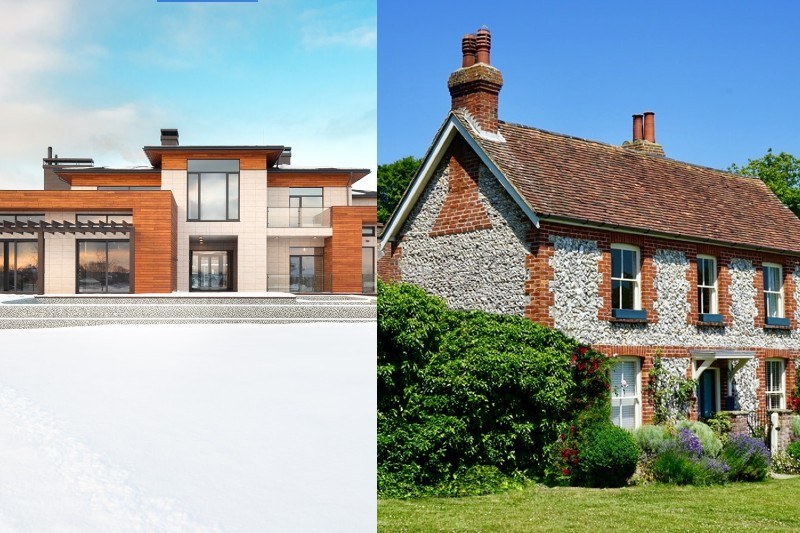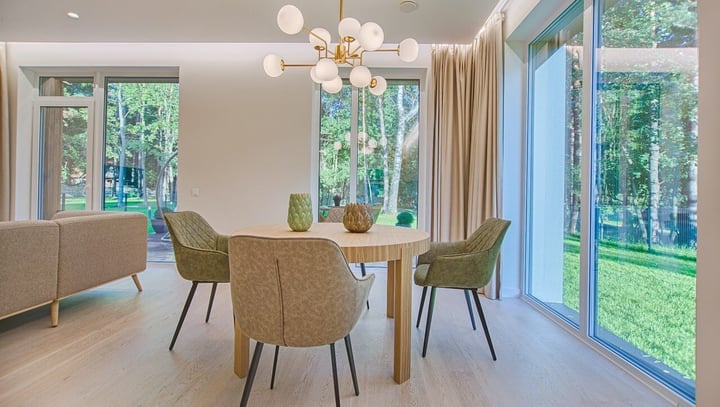
How Much to Put Down on a House: the Problems with 20%
Posted on Apr 19, 2022

Posted on Apr 19, 2022
According to data from Trulia, the American public is fairly split on whether they prefer a newly built home or an old home. Assuming the same price, 41% of Americans prefer to buy a newly built home, while 21% prefer an existing home. But the remaining 38% have no preference.
Opinions on buying a new house vs old are mixed - and in this market, having a clear idea of what you want is important, since homebuyers need to make extremely quick decisions if they want to stand a chance at getting the home of their dreams.
So what should you know about the benefits and drawbacks of new homes vs existing homes? Read on to find out.
Most components of your home come with an expiration date. The average asphalt roof, for example, lasts about 25 years - at which point it will need to be replaced. The same can be said for other parts of your home - wooden window frames can warp and rot, refrigerators need replacing, HVAC units break down, etc.
When you buy a newer home, you’re unlikely to deal with any major issues right away. In fact, you might move to your next home before any major repairs arise. When you have an old home, though, you might find yourself dealing with a burst pipe or a leaking roof within the first six months of living there. New homes tend to be in better condition.
Newly constructed homes, in particular, are unlikely to have any major issues because they’re inspected at multiple points during construction.
“Not only is new construction covered by warranty - at every step of the construction process, a county inspector has to come in. So you know it’s passed all these little inspections - every kind of test - and then you get the certificate of occupancy. So the new home has been thoroughly inspected,” explains Jacksonville-based buyer agent Lee Krause.
Even if an inspector is very thorough in their examination of an old home, there are natural limits to how much they can detect.
“With older homes, they’re not going to peel back roof tiles or take away your ceiling board during an inspection. You also didn’t have the different tiers of construction inspections if it was built 100 years ago - and they didn’t do a lot of inspections in general. Of course, those homes were built by someone who knew how to build a home and they’re usually pretty sturdy, but I think older-home buyers need to expect that the home needs repairs beyond what you can see with your eye. Whereas with a new home, you don’t have anything like that,” notes Krause. "There’s always going to be something to repair on an older home - that’s just the way it is.”
The phrase “they don’t make ‘em like they used to” will rile up many a home builder, and you will never get a clear answer as to whether homes were built better in the past or the present - in part because every home is different, and also because a home can be built with stronger wood yet have sub-par fire resistance.
Modern homes are built to more stringent standards of safety and uniformity than homes of the past. A modern home, for example, is never going to have lead paint on the walls - or untreated, shredded newspaper as insulation (and potential fire kindle).
On the other hand, modern construction often favors the cheapest solutions to putting up a home in order to keep costs palatable to the buyer. And like anything, sometimes our contemporary solutions just aren’t the same: for example, builders can no longer typically access the old-growth hardwood that was common in early 1900 homes. The majority of wood used in construction today is young - and the fewer the rings, the weaker the wood. Modern building also favors 2x4 frame construction, whereas old homes often have 2x6 studs - which are more expensive but generally create a sturdier, better-insulated home.
With that said, some modern home builders have better reputations than others. If you’re opting for new construction and accepting bids, don’t just opt for the lowest bid. And always take a look at reviews from past clients!

Homes are an interesting asset because unlike cars or clothing, they tend to appreciate over time, rather than depreciate. While many sources will tell you that newer homes are more expensive than older homes, the key metric to pay attention to is the cost per square foot.
Newer homes are undeniably larger than older homes - and square footage increases home price. So it’s often misleading to say that “new homes cost more”- when what we really mean is “larger homes cost more.” According to The Balance, “There’s no clear relationship between the age of a home and its price.”
However, right now the cost of new construction has risen thanks to supply chain issues, economic sanctions, labor crunches, rising fuel prices, and more - so you might indeed find that new construction is more expensive.
New homes are built to be more energy-efficient, which is better for both the environment and your wallet. Almost every stage of construction can improve energy efficiency - for example, new homes feature contemporary HVAC units that maximize airflow while minimizing leakage. Older homes, by contrast, have aging ductwork that develops leakage over time - costing you money in lost heating and cooling. Double-paned windows come standard with new homes and are 30-50% more energy-efficient than single-paned windows. Retrofitting an old home with new windows, though, can set you back many thousands of dollars.
If you’re looking to put a number on it, the data is clear on new homes vs. new homes: “Newer homes use about 20% less energy to heat their internal space, despite the size increase in homes,” as reported by the Energy Information Administration. That can translate into big energy cost savings over the years. And according to the U.S. Census Bureau’s American Housing Survey, homeowners in old homes spend 17% more on electricity and 38% more on gas per year.

If you’re worried about safety, new homes will probably be a better choice. Of course, the likelihood of something terrible happening is low - every year, for example, only 0.276% of housing units have a fire (which means it’s fairly unlikely to happen to you). However, if an accident does happen, newer homes are held to higher standards of fire resistance, hurricane/earthquake resistance (if located in a relevant area), electrical safety, and more.
Older homes are usually underpowered, running on 60amp or 100amp service rather than the 200amp service that is standard for new construction. When homes are underpowered, they’re more likely to experience blown fuses, broken breakers, and power outages.
And when it comes to fire safety, many homes built prior to 1940 used balloon framing - an outdated form of construction that has no fire blocking - which means a fire can race from top to bottom incredibly fast.
Land - especially land in cities - has been in increasingly short supply, which is one vote in favor of older homes, which tend to be built on much larger parcels of land in established communities. Buy a new home and you might have a yard the size of a postage stamp and if you’re lucky, you might get a small sapling that won’t grow to full size for another two decades. Buy an older home and you’re more likely to land a dog-friendly-sized yard with beautiful, mature trees.
“As homes have grown larger, the lots they’re built on have actually gotten smaller - the average area is down 13% since 1978, to 0.19 acres. That might not seem like a lot, but after adjusting for houses’ bigger footprints, it appears the median yard has shrunk by more than 26%, and now stands at just 0.14 acres,” notes an article on shrinking home sizes via The Atlantic.
According to Kraus, younger/first-time homebuyers tend to prefer older homes because they can easily visualize exactly what they’re paying for - which can often be comforting when you're going through the process for the first time. Meanwhile, older homebuyers - who are often downsizing - tend to prefer new construction that won’t require as many expensive fixes and can be customized to their lifestyle needs.
“My preference would be new construction. Everything is new and it should function correctly. Older homes, you’ve got to be prepared that you could be buying a money pit. You can only go so far with inspections,” notes Krause.
Another benefit to moving into an existing home, rather than a new build: new construction timelines are incredibly delayed right now due to supply chain issues, inflation, and the general high demand for all types of housing. What used to take six months may now take up to a year - a difficult timeline for new homeowners to accommodate, especially if they’re trying to move out of a rental with a set lease.
There's no right answer, though, and sometimes the right home for you will be more determined by the neighborhood, commute time, kitchen size, etc. than it will be about new vs. old.
Not sure if you want old or new? Discuss with an agent
Subscribe to our newsletter to get essential real estate insights.

Posted on Apr 19, 2022

Posted on Apr 19, 2022
It's been a wild time to be a homeowner. Home values in Philadelphia increased by about 12% over...

Posted on Apr 19, 2022
List price and sale price are two different things - and that’s due in part to your initial offer...